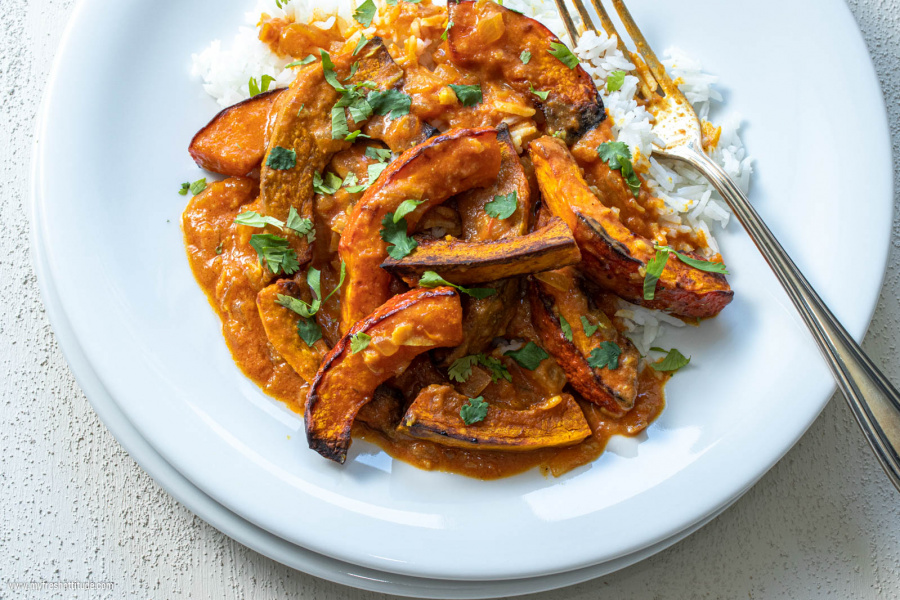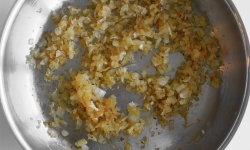
Roasted Pumpkin Curry
This is a variation of a classic Indian curry called Squash Malai Kari, which in its original form is made with prawns and plenty of coconut milk. It sounds delicious…but also not terribly vegan.
My adaptation leaves the prawns out completely. Instead, I elected to roast pumpkin wedges to create a chunkier version that will get somewhat close to the original recipe. I also replaced the coconut milk (I’m not a fan of coconut milk because of the amount of saturated fat) with a combination of unsweetened soy milk, coconut water and a good spoon of cashew butter. This technique works great to create a thick and tasty creamy sauce.
I tend to make this curry on the mild side, but it is also easy to adjust the heat levels to suit your own tastes by increasing the amount of cayenne, using a spicy curry paste and using a sharper curry powder.
Serve with basmati rice and maybe one or two vegan naan breads!
Yield: makes about 6-8 servings
1 ½ kg. (3 1/3 pounds) firm-fleshed pumpkin (see tips)
extra virgin olive oil to coat the pumpkin wedges
sea salt (you will need enough to season the pumpkin and the final recipe)
2 medium-size red onions, chopped in medium-dice
4 peeled garlic cloves, chopped or grated
2 teaspoons freshly grated ginger
5 tomatoes, pureed (see tips)
240 ml (1-cup) coconut water
240 ml (1 cup) unsweetened soy milk
1 1/2 tablespoons cashew butter
2 teaspoons ground cumin
½ teaspoon cayenne pepper
2 teaspoons mild curry powder
2 tablespoons yellow curry paste
2 tablespoons sugar
1 teaspoon ground cinnamon
juice of two limes
1 bunch coriander, chopped
- Preheat your oven to 200°C (390°F).
- Prepare your pumpkin (see tips below regarding need to peel). Remove the skin if necessary and all of the pulp and seeds (save these for a broth). Cut your prepared pumpkin into wedges – keep them chunky, but not huge. I like to think about eating this curry with a spoon and keeping one wedge on the spoon along with some of the sauce. Place the pumpkin in a large bowl. Toss with just enough extra virgin olive oil to coat the wedges evenly. Season with salt and mix well. Place the pumpkin on a baking sheet lined with baking paper – work in a tight single layer. Use two trays if they don’t fit on one. Place in your preheated oven. Bake for 15 minutes, then remove the tray and turn the pumpkin wedges carefully. Return to the oven for another 15 minutes. Remove and keep the pumpkin off to the side. You can complete this step 1-2 days in advance – just make sure to refrigerate your cooked pumpkin if you are keeping them longer than a day.
- Heat a large wide and shallow pot over medium heat. When the pan is hot, add your chopped onions and ½-teaspoon sea salt. Stir the onions to mix in the salt, then allow the onions to simply soften and stew in its own water. Add 2-3 tablespoons of water as necessary if the pan becomes dry. I’m not trying to caramelize the onions – just soften them. Be patient, this process will take your about 10-12 minutes.
- Once your onions are softened, add your grated garlic and ginger. Continue to sweat the mixture, making sure to take care in this step and avoid allowing the garlic to stick and burn…use a bit of water, but not too much. Cook for about 3 minutes.
- Add the tomato puree and continue to cook for about 5 minutes. Turn the heat up slightly during this step to allow the tomatoes to cook down a bit and thicken.
- Combine your coconut water, soy milk and cashew butter in a blender. Blend until smooth, then add to the pan. Add your ground cumin, cayenne pepper, curry powder, curry paste and sugar. Stir well to combine. Bring the mixture to a simmer and cook until the mixture thickens enough to coat your spoon. I like this curry relatively thick, but still with enough liquid to create a sauce and mix well with the rice I serve it with.
- Add the cinnamon and lime juice. Continue to cook for 3-5 minutes.
- To serve, add your cooked pumpkin wedges at the last moment, cook enough to heat them through and garnish with the chopped coriander.
Jack’s Fresh Tip

Your pumpkin selection for this recipe is key, so make a good decision. I like to use 2 or even 3 different varieties of pumpkin to create different flavors and textures. Kabocha-style pumpkins work very well in this recipe. They are usually a Japanese-variety with thick skins, firm flesh that is more yellow in color and flavors of chestnuts or even potatoes. You do need to take the skin off these pumpkins before roasting because they don’t break down so well in cooking and the flesh will hold together anyway. Another variety that is outstanding is the bright red Hokkaido variety. The bright orange flesh is a bit softer than Kabocha pumpkins, but the bonus is the skin, which can be left on and eaten – it is delicious and will help keep your wedges together.
Feel free to substitute a yellow or white onion for the red one – it won’t make a huge difference in the final dish.
Dry ginger can replace the fresh ginger, but you will need far less. Use about 1 teaspoon as your maximum amount.
We have some excellent guidance on making a fresh tomato puree in our techniques section. Use about 1 cup of drained chopped canned tomatoes as a replacement – it will help you to puree these as well.
Techniques used
This is a Sample Recipe
This is a variation of a classic Indian curry called Squash Malai Kari, which in its original form is made with prawns and plenty of coconut milk. It sounds delicious…but also not terribly vegan.
My adaptation leaves the prawns out completely. Instead, I elected to roast pumpkin wedges to create a chunkier version that will get somewhat close to the original recipe. I also replaced the coconut milk (I’m not a fan of coconut milk because of the amount of saturated fat) with a combination of unsweetened soy milk, coconut water and a good spoon of cashew butter. This technique works great to create a thick and tasty creamy sauce.
I tend to make this curry on the mild side, but it is also easy to adjust the heat levels to suit your own tastes by increasing the amount of cayenne, using a spicy curry paste and using a sharper curry powder.
Serve with basmati rice and maybe one or two vegan naan breads!
Yield: makes about 6-8 servings

